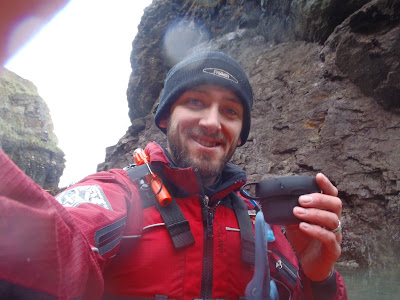
St Brides Haven
I leave St Brides Haven with the aim to bridge a section of the Pembrokeshire coast I have yet to complete from here to Solva, otherwise known as St Brides Bay.

Stack Rocks from Halfway Rock (the Camel formation is clear to the left of Stack Rocks)
Forecast wasn't the best but with five kids currently over my house I take my chances and escape the madness. Force 4-5 possible 6 North Easterly, sea state moderate, showers. I figured this section of the coast should be mostly sheltered from the worst of the winds.

Syncline fold in the Old Red Sandstone
The geology either side of St Brides Haven is mainly Old Red Sandstone, which make the cliffs really stand out.

Nearing Mill Haven you can clearly see where the Old Red Sandstone ends and is replaced with the Grey Igneous Rock of the Pre-Cambrian period. It was a really dull miserable day, not good for taking photo's.

Through Howney Stone opposite Stack Rocks the sea state picked up with brisk wind causing waves to break. A lone Razor Bill was bobbing about in the waves, most have now migrated for the winter.

The grey igneous rocks are now distinctively different to the deep red cliffs near St Brides. This irregular belt between Mill Haven and Little Haven is known as the Johnston Series and are the oldest rocks in Pembrokeshire (well over 1,000 million years).

The old igneous headlands are more typical in the north of Pembrokeshire, Dinas Head, Stumble for instance. South Pembrokeshire is mainly made up of sediments which are much younger.

From Musselwick just before Little Haven the geology turns to 'coal measures' made up of Sandstone and Shales, Millstone Grit and thin Anthracite Coal Seams. These are the youngest rocks in Pembrokshire (280 million years old).
I got very close to an Otter in this cove, I don't think he saw me. Although by the time I removed my gloves to get my camera out he disappeared beneath the water.
I got very close to an Otter in this cove, I don't think he saw me. Although by the time I removed my gloves to get my camera out he disappeared beneath the water.

Layers of alternating stone can clearly be seen here up on the cliff. Black Mudstone collected on the sea floor then as they shallowed a thin layer of fine sandstone sits on top. Thick layers of Sandstone lay on top of that from delta deposits, bleached due to leaching in a tropical environment.

Extreme folds in the sediment can be seen at either ends of the bays at Little and Broad Haven.

It's now easy to understand how St Brides Bay has been formed. The brittle softer rock has given way to the ongoing pounding of the sea forming shallow bays cut into the coal measures leaving harder sandstones at the headlands.

Sleek Stone
At the end of Broad Haven beach is an impressive Monocline formation (asymmetrical up-fold in the strata) known as Sleek Stone. The rock resembles a huge beached whale with a big bite out of it!

Following the coast toward Druidston, named after a 12th century knight who settled here, the cliffs show more evidence of the erosion that continues to eat away at the cliffs.

Haroldston Bridge
It is now low tide so I am unable to pass under Haroldston Bridge, a natural arch linking a small rocky outcrop to the main cliff.

I stop off at a small inaccessible bay just prior to Druidston Haven but it's too cold to stop for long. I don't know why maybe it's the miserable weather but I didn't have the motivation in me to carry on any further. So I continue on a little further with Rickets Head south of Newgale in view before turning back.

I paddle into the small sheltered lagoon under Haroldston Bridge on the way back for a cuppa to warm me up.
Whilst having a cuppa I caught a sight of a Peregrine leaving the cliff with what looked like a small bloodied rodent in it's talons.

Passing Broad Haven the surf which was more evident earlier had ceased so I landed at Small Haven in front of this impressive looking cave.
Continuing my journey the sea state got worse the further south I went. I decide not to make the small detour out to Stack Rocks.

I chased this Curlew most of the way back, every time I got within shooting distance he flew off. I finally managed to get this shot.

It made for some good rock-hopping opportunities amongst the red stones with the tide being so low. It also kept me out of the wind.

Typically the sun decided to show it's face when I got back to St Brides Haven so I took a short walk up the coastal path to The Nab Head.






3 comments:
Excellant trip, I certainly can't correct any geology mistakes but it makes an interesting read! Keep em coming, I'm gagging to get out somewhere, but it cost me nearly £100 to do a trip to the cost and back inc food camping etc.
No you probably couldn't get any more in the center of the country! Any lakes in the Peak District? Although your probably about the same distance from North Wales as I am from West Wales. It's costs me about £20-30 petrol to Pembrokeshire and I sleep in my van or on the beach. I try and go west at least once a month. Not long till your new year trip it'll soon fly by.
If I get up really early on a saturday, (330am) and head to Angelsey, I can be on the water for 730 ish. If I stay over it costs me around a hundred round trip. its a 150 miles so not too far really.
The New Year trip will be interesting, I nearly got snowed in last year!
Post a Comment